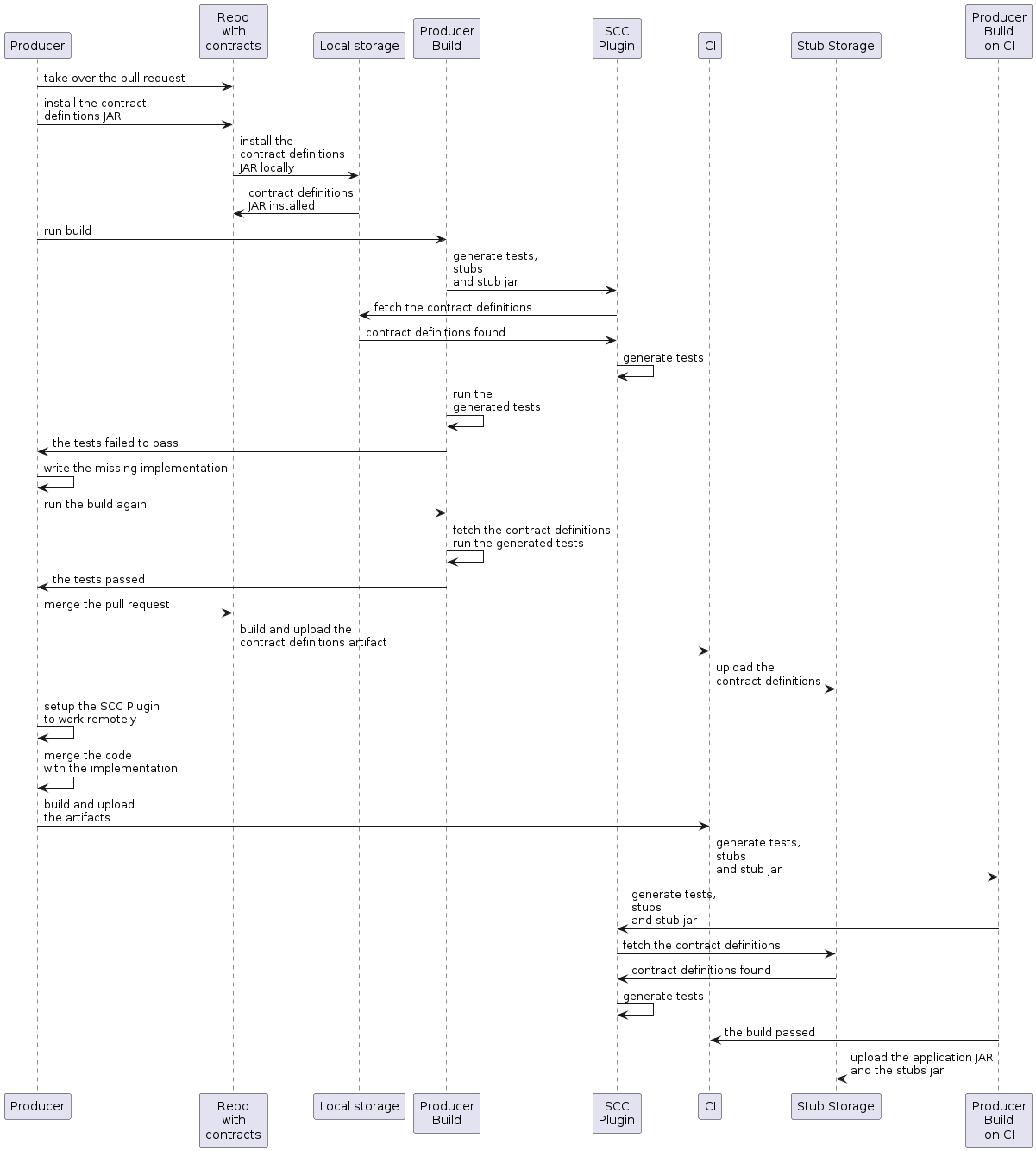基于外部仓库契约的消费者驱动契约
在这个流程中,我们执行消费者驱动契约测试。契约定义存储在一个独立的仓库中。
先决条件
要使用基于外部仓库契约的消费者驱动契约,你需要设置一个 Git 仓库,该仓库需要:
-
包含每个生产者的所有契约定义。
-
能够将契约定义打包成 JAR。
-
对于每个契约生产者,包含一种方式(例如
pom.xml)通过 Spring Cloud Contract 插件 (SCC Plugin) 在本地安装存根。
你还需要设置了 Spring Cloud Contract Stub Runner 的消费者代码。此类项目的示例请参阅这个示例。你还需要设置了 Spring Cloud Contract 和其插件的生产者代码。此类项目的示例请参阅这个示例。存根存储可以是 Nexus 或 Artifactory。
概括而言,流程如下:
-
消费者使用来自独立仓库的契约定义进行工作。
-
消费者工作完成后,在消费者侧创建一个包含工作代码的分支,并向保存契约定义的独立仓库提交一个 pull request。
-
生产者接管向保存契约定义的独立仓库提交的 pull request,并在本地安装包含所有契约的 JAR。
-
生产者从本地存储的 JAR 生成测试,并编写缺失的实现代码以使测试通过。
-
生产者工作完成后,合并向保存契约定义的仓库提交的 pull request。
-
CI 工具构建保存契约定义的仓库并将包含契约定义的 JAR 上传到 Nexus 或 Artifactory 后,生产者可以合并其分支。
-
最后,消费者可以切换到在线工作模式,从远程位置获取生产者的存根,并将该分支合并到主分支。
消费者流程
消费者:
-
编写一个向生产者发送请求的测试。
由于没有服务器存在,测试失败。
-
克隆保存契约定义的仓库。
-
在文件夹下设置需求作为契约,以消费者名称作为生产者的子文件夹。
例如,对于名为
producer的生产者和名为consumer的消费者,契约将存储在src/main/resources/contracts/producer/consumer/目录下。 -
定义契约后,将生产者存根安装到本地存储,如下例所示:
$ cd src/main/resource/contracts/producer $ ./mvnw clean install -
在消费者测试中设置 Spring Cloud Contract (SCC) Stub Runner,以便:
-
从本地存储获取生产者存根。
-
在 stubs-per-consumer 模式下工作(这启用消费者驱动契约模式)。
SCC Stub Runner 会:
-
获取生产者存根。
-
运行一个包含生产者存根的内存中 HTTP 服务器存根。现在你的测试与 HTTP 服务器存根通信,并且你的测试通过。
-
向保存契约定义的仓库创建一个包含生产者新契约的 pull request。
-
分支你的消费者代码,直到生产者团队合并他们的代码。
-
以下 UML 图显示了消费者流程:

生产者流程
生产者:
-
接管向保存契约定义的仓库提交的 pull request。你可以从命令行执行此操作,如下所示:
$ git checkout -b the_branch_with_pull_request master git pull https://github.com/user_id/project_name.git the_branch_with_pull_request -
安装契约定义,如下所示:
$ ./mvnw clean install -
设置插件从 JAR 而非
src/test/resources/contracts中获取契约定义,如下所示:- Maven
-
<plugin> <groupId>org.springframework.cloud</groupId> <artifactId>spring-cloud-contract-maven-plugin</artifactId> <version>${spring-cloud-contract.version}</version> <extensions>true</extensions> <configuration> <!-- We want to use the JAR with contracts with the following coordinates --> <contractDependency> <groupId>com.example</groupId> <artifactId>beer-contracts</artifactId> </contractDependency> <!-- The JAR with contracts should be taken from Maven local --> <contractsMode>LOCAL</contractsMode> <!-- ... additional configuration --> </configuration> </plugin> - Gradle
-
contracts { // We want to use the JAR with contracts with the following coordinates // group id `com.example`, artifact id `beer-contracts`, LATEST version and NO classifier contractDependency { stringNotation = 'com.example:beer-contracts:+:' } // The JAR with contracts should be taken from Maven local contractsMode = "LOCAL" // Additional configuration }
-
运行构建以生成测试和存根,如下所示:
- Maven
-
./mvnw clean install - Gradle
-
./gradlew clean build
-
编写缺失的实现代码,以使测试通过。
-
合并向保存契约定义的仓库提交的 pull request,如下所示:
$ git commit -am "Finished the implementation to make the contract tests pass" $ git checkout master $ git merge --no-ff the_branch_with_pull_request $ git push origin masterCI 系统构建包含契约定义的项目,并将包含契约定义的 JAR 上传到 Nexus 或 Artifactory。
-
切换到远程工作模式。
-
设置插件以便契约定义不再从本地存储获取,而是从远程位置获取,如下所示:
- Maven
-
<plugin> <groupId>org.springframework.cloud</groupId> <artifactId>spring-cloud-contract-maven-plugin</artifactId> <version>${spring-cloud-contract.version}</version> <extensions>true</extensions> <configuration> <!-- We want to use the JAR with contracts with the following coordinates --> <contractDependency> <groupId>com.example</groupId> <artifactId>beer-contracts</artifactId> </contractDependency> <!-- The JAR with contracts should be taken from a remote location --> <contractsMode>REMOTE</contractsMode> <!-- ... additional configuration --> </configuration> </plugin> - Gradle
-
contracts { // We want to use the JAR with contracts with the following coordinates // group id `com.example`, artifact id `beer-contracts`, LATEST version and NO classifier contractDependency { stringNotation = 'com.example:beer-contracts:+:' } // The JAR with contracts should be taken from a remote location contractsMode = "REMOTE" // Additional configuration }
-
合并包含新实现的生产者代码。
-
CI 系统会:
-
构建项目。
-
生成测试、存根和存根 JAR。
-
将包含应用程序和存根的 artifact 上传到 Nexus 或 Artifactory。
-
以下 UML 图显示了生产者流程:


